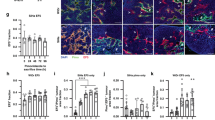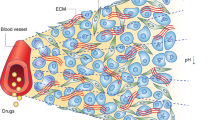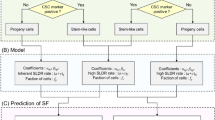Abstract
C3H/He mice bearing SCC VII tumours received 5-bromo-2'-deoxyuridine (BrdU) continuously for 5 days via implanted mini-osmotic pumps in order to label all proliferating (P) cells. The tumours were then heated at 40 degrees C for 60 min. At various time points after heating, tumour-bearing mice were irradiated while alive or after being killed. Immediately after irradiation, the tumours were excised, minced and trypsinized. The tumour cell suspensions obtained were incubated with cytochalasin-B (a cytokinesis blocker), and the micronucleus (MN) frequency in cells without BrdU labelling, which could be regarded as quiescent (Q) cells, was determined using immunofluorescence staining for BrdU. The MN frequency in the total (P+Q) tumour cell population was determined from the irradiated tumours that were not pretreated with BrdU. The MN frequency of BrdU unlabelled cells was then used to calculate the surviving fraction of the unlabelled cells from the regression line for the relationship between the MN frequency and the surviving fraction of total (P+Q) tumour cells. In general, Q cells contained a greater hypoxic fraction (HF) than the total tumour cell population. Mild heating decreased the HF of Q cells more markedly than in the total cell population, and the minimum values of HFs of both total and Q cell populations were obtained 6 h after heating. Two days after heating, the HF of total tumour cells returned to almost that of unheated tumours. In contrast, the HF of Q cells did not return to the HF level of unheated tumours until 1 week after heating. It was thought that irradiation within 12 h after mild heating might be a potentially promising therapeutic modality for controlling radioresistant Q tumour cells.
This is a preview of subscription content, access via your institution
Access options
Subscribe to this journal
Receive 24 print issues and online access
$259.00 per year
only $10.79 per issue
Buy this article
- Purchase on Springer Link
- Instant access to full article PDF
Prices may be subject to local taxes which are calculated during checkout
Similar content being viewed by others
Author information
Authors and Affiliations
Rights and permissions
About this article
Cite this article
Masunaga, S., Ono, K., Akaboshi, M. et al. Reduction of hypoxic cells in solid tumours induced by mild hyperthermia: special reference to differences in changes in the hypoxic fraction between total and quiescent cell populations. Br J Cancer 76, 588–593 (1997). https://doi.org/10.1038/bjc.1997.430
Issue Date:
DOI: https://doi.org/10.1038/bjc.1997.430
This article is cited by
-
Significance of manipulating intratumor hypoxia in the effect on lung metastases in radiotherapy, with reference to its effect on the sensitivity of intratumor quiescent cells
Clinical & Experimental Metastasis (2009)
-
Evaluation of hypoxia-specific cytotoxic bioreductive agent-sodium borocaptate-10B conjugates as10B-carriers in boron neutron capture therapy
Radiation Medicine (2006)
-
Potential of α-amino alcohol p-boronophenylalaninol as a boron carrier in boron neutron capture therapy, regarding its enantiomers
Journal of Cancer Research and Clinical Oncology (2003)



